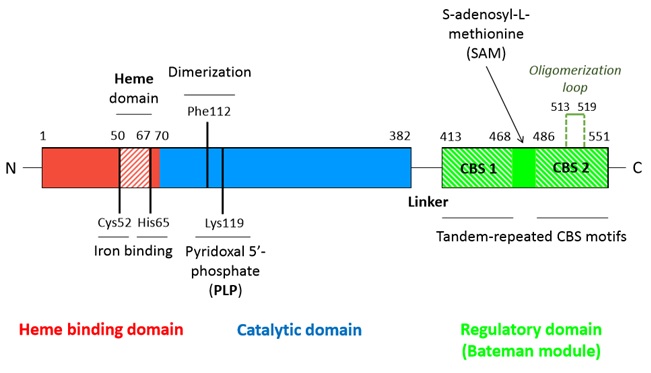Sandbox Reserved 1126
From Proteopedia
(Difference between revisions)
| Line 34: | Line 34: | ||
The hCBS is natively a homotetrameric enzyme. It is suggested that two monomers form a dimer, and then two dimers form a tetramer. | The hCBS is natively a homotetrameric enzyme. It is suggested that two monomers form a dimer, and then two dimers form a tetramer. | ||
| - | *Dimer formation | + | *Dimer formation |
| + | Two monomers shape a dimer through both hydrophobic and polar interactions within the catalytic core. Hydrophobic interactions particularly involve two Phe112 (one from each monomer) which interact with each other. There are no interactions between Bateman modules in a single dimer concerning hCBS. | ||
| - | * Tetramer formation involves the Bateman modules as well as the catalytic core of each dimer. Each <scene name='71/719867/Scene_3/1'>oligomerization loop</scene> (loop 513-519) of a monomer of one dimer interacts with the catalytic core of a monomer of the other dimer. Those loops interact within a crevace (shaped by α-helix 5-6-12-15-16 and β-strands 5-6) of the catalytic core. The tetramer is an inactive form of the enzyme. | + | * Tetramer formation |
| + | It involves the Bateman modules as well as the catalytic core of each dimer. Each <scene name='71/719867/Scene_3/1'>oligomerization loop</scene> (loop 513-519) of a monomer of one dimer interacts with the catalytic core of a monomer of the other dimer. Those loops interact within a crevace (shaped by α-helix 5-6-12-15-16 and β-strands 5-6) of the catalytic core. The tetramer is an inactive form of the enzyme. | ||
| Line 49: | Line 51: | ||
== Allosteric regulation == | == Allosteric regulation == | ||
| - | *Autoinhibition (at the dimer scale) | + | *Autoinhibition (at the dimer scale) |
The Bateman modules natively prevents the access of the substrates to the catalytic site (PLP cavity) through loops 145-148, 171-174, 191-202 (closed state). | The Bateman modules natively prevents the access of the substrates to the catalytic site (PLP cavity) through loops 145-148, 171-174, 191-202 (closed state). | ||
| - | *Activation by SAM | + | *Activation by SAM |
S-adenosyl-methionine seems to bind in a region located between the CBS1 and CBS2 domains of the Bateman module since it is solvent-exposed and has no hefty residues. Moreover, this region shapes a hydrophobic cage able to host the adenine ring. Moreover threonine (T535) and aspartate (D538) help stabilizing the ribose through hydrogen bounds and polar interactions. | S-adenosyl-methionine seems to bind in a region located between the CBS1 and CBS2 domains of the Bateman module since it is solvent-exposed and has no hefty residues. Moreover, this region shapes a hydrophobic cage able to host the adenine ring. Moreover threonine (T535) and aspartate (D538) help stabilizing the ribose through hydrogen bounds and polar interactions. | ||
Revision as of 19:21, 29 January 2016
| This Sandbox is Reserved from 15/12/2015, through 15/06/2016 for use in the course "Structural Biology" taught by Bruno Kieffer at the University of Strasbourg, ESBS. This reservation includes Sandbox Reserved 1120 through Sandbox Reserved 1159. |
To get started:
More help: Help:Editing |
Human cystathionine β-synthase (hCBS)
| |||||||||||

